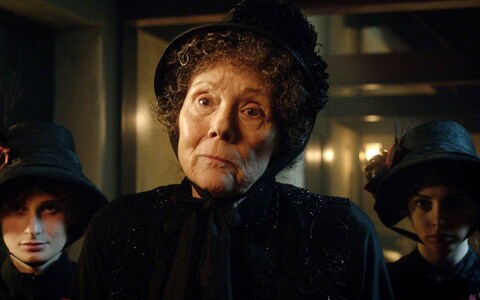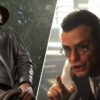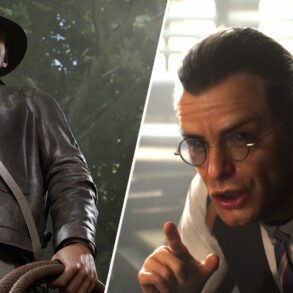Doctor Who is one of the most stellar science fiction franchises ever – but when it’s bad, it is atrocious. As the BBC’s time-hopping maverick marks his /her 60th anniversary, even hardcore Whovians will admit the Doctor’s duff moments are dire.
Aliens fashioned from bin-liner, scripts that are both bonkers and boring, special effects apparently cobbled together on an Amstrad 464 – when it comes to catastrophic telly, the Doctor wins first prize.
Hang on to your sonic screwdriver as we bring you the 10 worst Doctor Who episodes.
The Web Planet (1965)
Battle of the Zarbi and Menoptera
Credit: BBC
William Hartnell’s original Doctor tangles with the Zarbi – an ant-like race enslaved by the parasitic Animus, which is covering the planet Vortis in webs. All clear? Good, because this is where it gets complicated. The Zarbi are ancient enemies of the butterfly-like Menoptera, who are invading the Zarbi’s homeland. Writer Bill Strutton saw the Menoptera and the Zarbi as representing the conflicting forces of capitalism and communism (welcome to the mid-Sixties). It’s a promising premise let down by the appalling costumes of both the Ant-men and the Butterfly-guys and by the decision to have the Zarbi communicate in annoying bleeps. The Web Planet was thought to have been wiped by the BBC for years – but the original prints were later recovered. They serve as a warning from history: Bad Who is in a class of its own.
The Underwater Menace (1967)
An early atrocity from Second Doctor Patrick Troughton, The Underwater Menace ticks all boxes for a true Who howler. Troughton’s Doctor visits a volcanic island where the survivors of Atlantis have made their home. Sadly, the BBC makes a proper Captain Birdseye of its “fish people” – outfitting them with dodgy goggles and iffy tights.
Troughton maintains his dignity as Doctor’s assistant Polly (Anneke Wills) is whisked off for “conversion surgery” that will turn her into a fish-lady. Behind the scenes, though, he was less than impressed, expressing frustration with the “ridiculous costumes and make-up of the fish people”. Producer Innes Lloyd agreed, lamenting The Underwater Menace looked “like something from a ‘Fifties American B movie’”. Parts two and three of the four-part story can be enjoyed – if that’s the word – on iPlayer, but instalments one and four fell victim to the BBC’s notorious policy of wiping old Doctor Who episodes (the Beeb has since filled in the blanks with an animated adaptation).
Warriors of the Deep (1984)


The fearsome Myrka
Credit: BBC
Even perpetually chipper Fifth Doctor Peter Davison looks fed up confronted with one of the worst ever Doctor Who monsters in the Myrka – a pantomime horse as designed by HP Lovecraft. Blame Margaret Thatcher – when she announced a surprise General Election in 1983, the BBC had to scramble to catch up, and two weeks were trimmed from the production time of Warriors of the Deep. The Myrka was finished just an hour before it was due on set, and the costume “smelt strongly of paint and adhesive” – one of the two puppeteers steering the creature felt like he was “sniffing glue”. Meanwhile, the paint on the beastie had not dried and rubbed off on the walls. Years later, former BBC Controller Michael Grade would cite the Myrka as an example of why he hated Doctor Who (in 1985, he put Who on an 18-month hiatus – it was eventually cancelled in 1989).
Timelash (1985)
Long before Jodie Whittaker’s run-ins with real historical figures such as Rosa Parks, Ada Lovelace and Mary Shelley, Colin Baker’s Sixth Doctor crosses paths with HG Wells. But what a missed opportunity their meeting proves. The plot concerns a sort-of time corridor – aka a Timelash – which the evil ruler of the planet Karfel is using as a prison for dissidents and which, for “reasons”, leads directly to Victorian Britain and young HG Wells (David Chandler).
The acting is over the top, though not in a good way. “Save your breath for the Timelash, Doctor,” says the villainous Tekker (Blake’s 7’s Paul Darrow). “Most people depart with a scream!”. However, as is often the case with Doctor Who, the real issue is the bargain bin production values. The supposedly terrifying Timelash, for instance, looks like it was constructed from yard sale bric-a-brac. Science fiction magazine editor Graham Sleight despaired of the “weak script, cheap-looking design, unimaginative direction, laughable special effects and some appalling performances”. “Grindingly dull story only memorable for being made as a school panto with belated New Romantic 80s fashion errors,” agreed Doctor Who expert Tat Wood.
Time and the Rani (1987)
The original, pre-Russell T Davies Doctor Who was on its last legs by the time Sylvester McCoy made his debut in this four-episode arc. His predecessor Colin Baker had left in a huff – and refused to return to portray the Doctor in the regeneration sequence that precedes the opening credits. This leaves McCoy to play both the old and new Doctors (his face is hidden until the end of the regeneration).
The story begins with the Tardis coming under attack from Kate O’Mara’s renegade Time Lady, the Rani. His memory temporarily wiped, McCoy’s seventh Doctor is hoodwinked into helping the Rani construct a machine that will disrupt space and time.
The premise isn’t uninteresting – the problem is the inept pacing and stodgy dialogue. Even as BBC executives were keen to euthanise Doctor Who, it felt as if the show was trying to send its audience to sleep. The bad taste has lingered: in 2014, readers of Doctor Who Magazine voted Time and the Rani one of their least favourite episodes. “This was a story which wasn’t about anything—and, frustratingly, it was Sylvester McCoy’s debut,” Who script editor Andrew Cartmel would lament.
The Unicorn and the Wasp (2008)
David Tennant remains one of the most popular Doctors – but even he had his misfires. This lurch at cosy crime – featuring a cameo from Fenella Woolgar as Agatha Christie – feels particularly cack-handed. The script is crammed with Christie references. So much so that the episode comes off as more Christie homage than Doctor Who. Even worse is the big reveal that the villain is a giant wasp in human form – a twist unworthy of Doctor Who and of Agatha Christie, who would not appreciate having her reputation keel-hauled across time and space in such a fashion.
The Crimson Horror (2013)


Diana Rigg as a mad scientist in The Crimson Horror
Credit: Adrian Rogers
Matt Smith would go on to play Prince Philip in The Crown after hanging up his sonic screwdriver. But before making it to Buckingham Palace, there was time for this royal flop of an instalment – in which the Doctor finds himself in Victorian Yorkshire, where Diana Rigg chomps down on the scenery as a mad scientist. The episode is conceived as a love letter to Sixties spy shows such as Rigg’s The Avengers. Ironically, it was hampered by her over-the-top performance – and the fact her character is in cahoots with a rubber worm named Mr Sweet.
The Return of Doctor Mysterio (2016)
A Christmas Day special from Steven Moffat was simultaneously treacly and tedious. It begins with the Doctor accidentally helping an eight-year-old boy transform into a superhero. Twenty-five years later, the boy is still a superhero, named Ghost, which is when he has another run-in with the Doctor in a glum storyline involving giant brains trying to take over the world. Capaldi – great as the grumpy Doctor – appears visibly frustrated by the sentimental tone of an episode that lurches between sappy and boring.
Arachnids in the UK (2018)
Jodie Whittaker has had the hardest time of any modern resident of the Tardis. Not only did she have to deal with internet trolls unable to handle a female Doctor – she also had to negotiate Chris Chibnall’s awful scripts. One early clanger sees her battling giant spiders while assisted by a Donald Trump-type blowhard politician played by the (since cancelled) Mr Big from Sex and the City, Chris Noth. The spiders are decently rendered, but Noth’s Trump-u-like is straight from the pantomime, while the ending in which the Doctor decides to lure the spiders into a room where they can be humanly euthanised is hugely creepy. The Doctor sending giant spiders to a glorified gas chamber is not how the BBC would have wanted the Whittaker era to begin.
Village of The Angels (2021)


“A Worst Doctor Who” top 10 could consist entirely of Chibnall episodes. Of his many atrocious outings, one of the most egregious is surely Village of the Angels. It had all the usual Chibnall flaws – a nonsensical storyline, dreary pacing and too much of a focus on the Doctor’s companions. But its worst sin is to take the greatest Doctor Who villain of all, the Weeping Angels, strip away all their terror and mystique and turn them into bang average baddies.
This post was originally published on this site be sure to check out more of their content.





